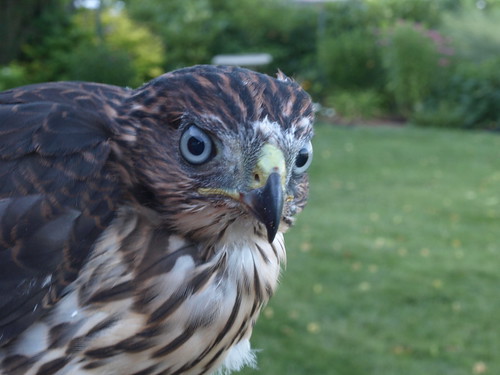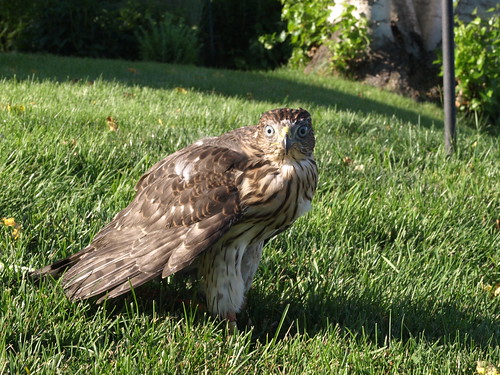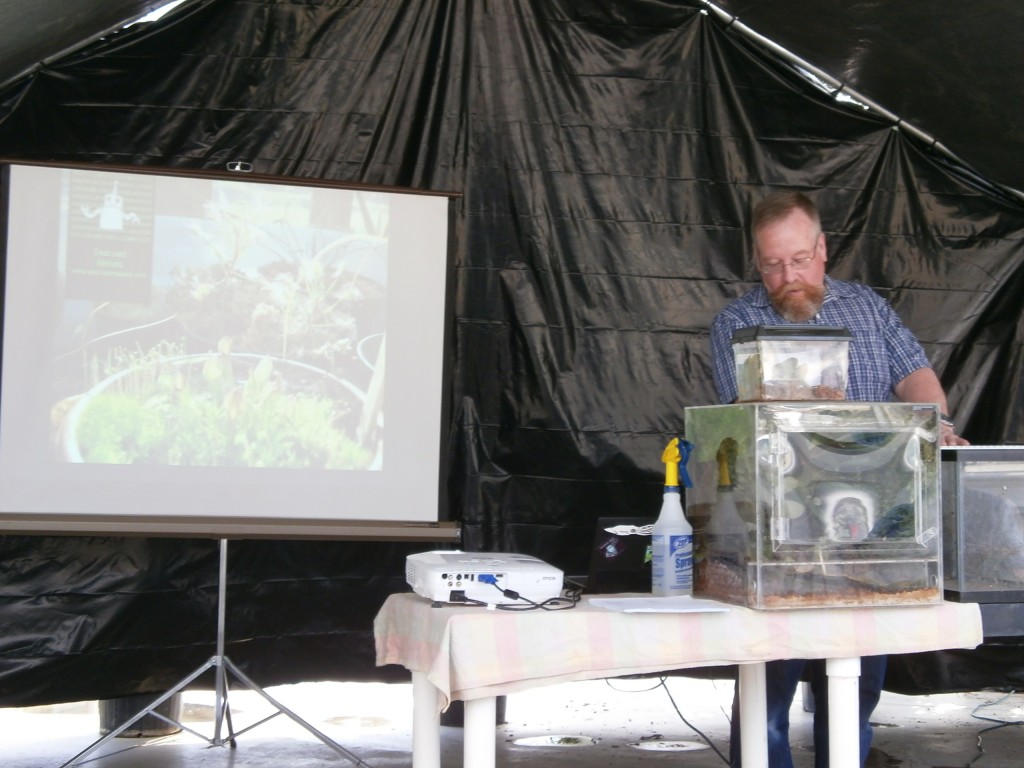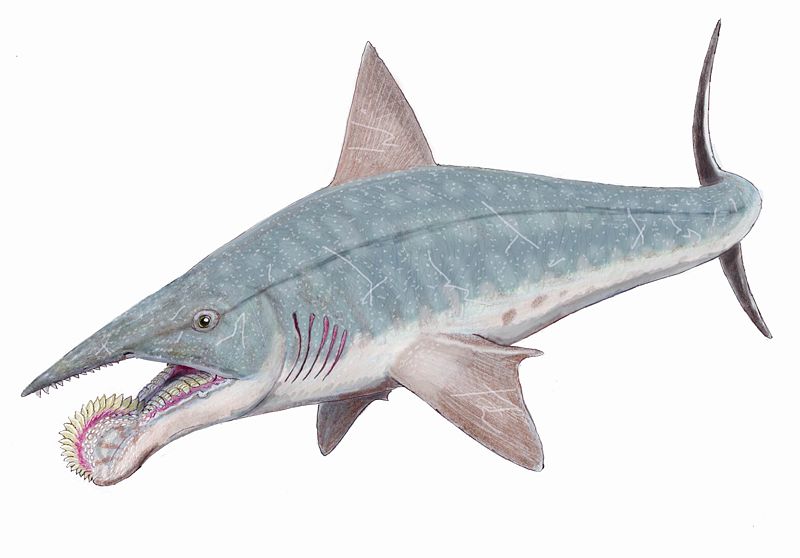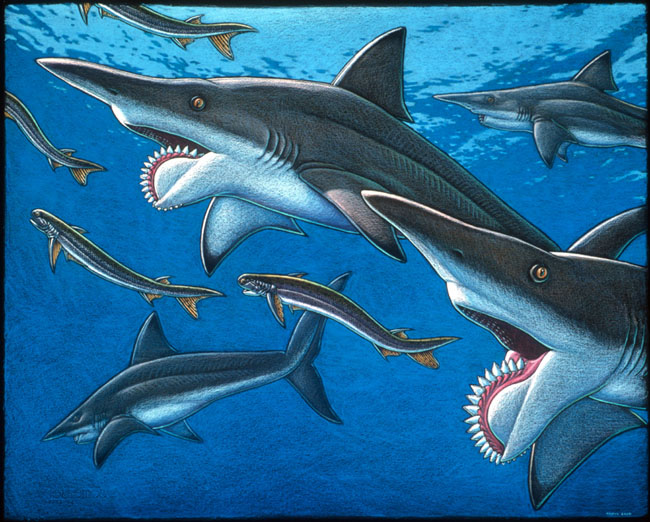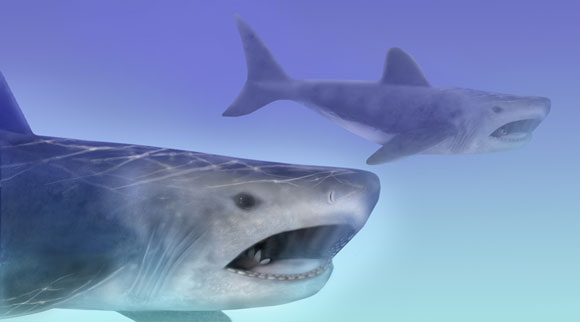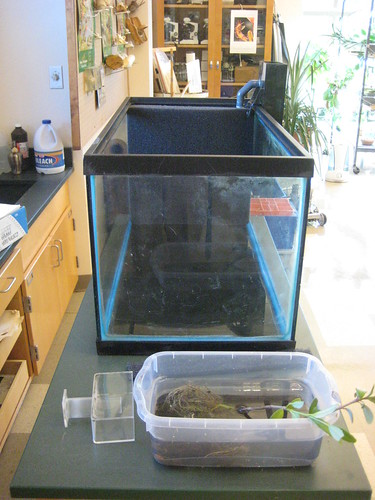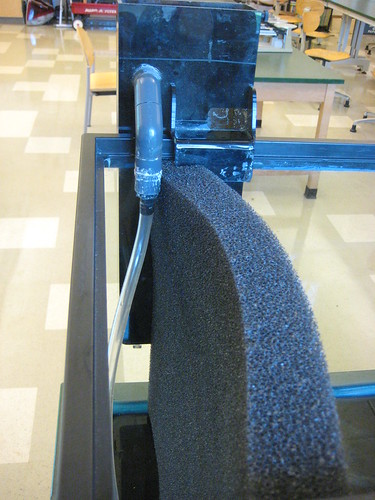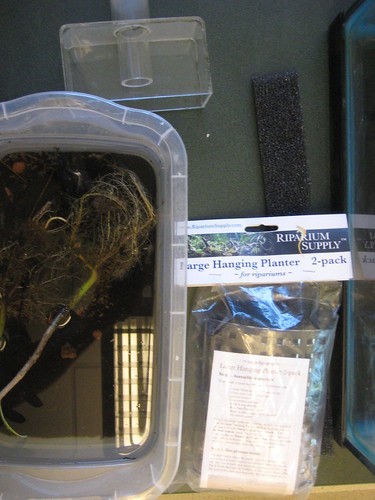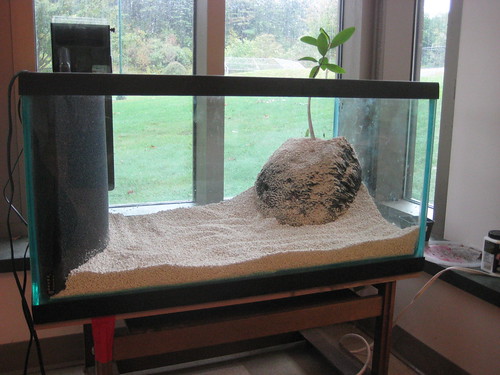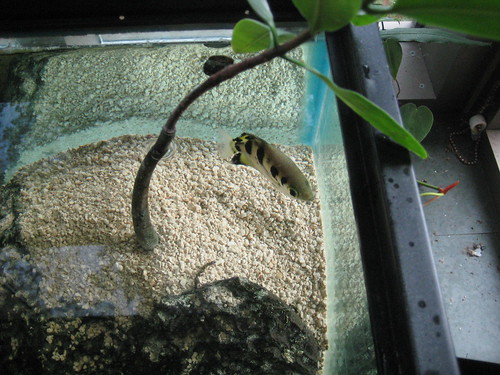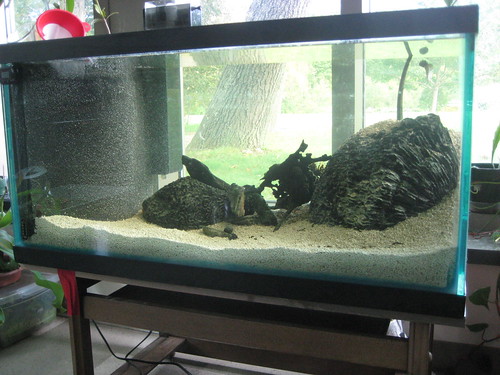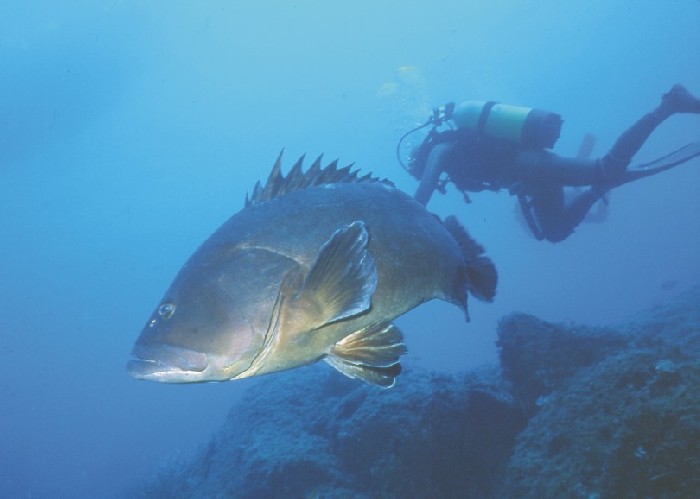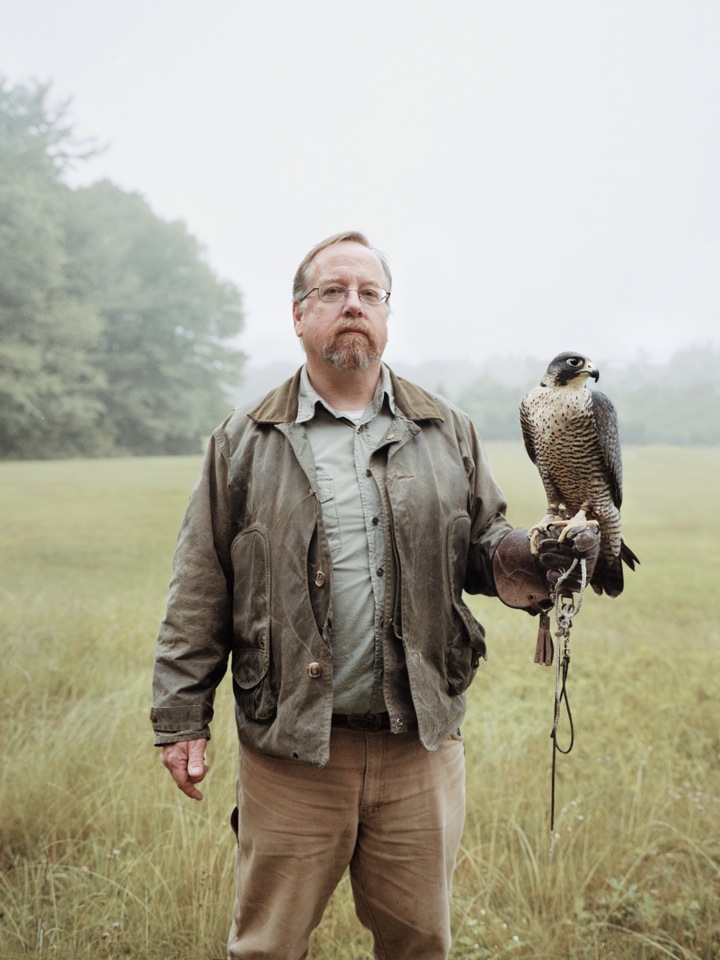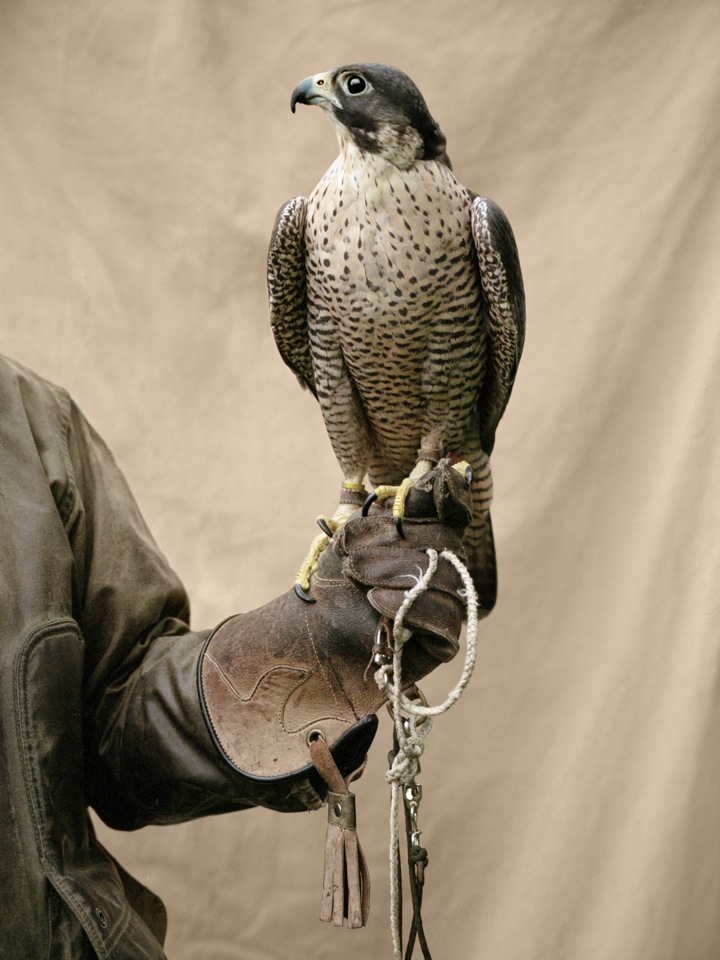A friend’s male (musket?) Cooper’s Hawk. If this is the look one would get from an incoming Dromaeosaurid, heart attack would be a likely cause of prey death.
Category Archives: creatures
The Great Eagle/Weasel Thread
I love twitter. See also Steve’s post.
Dogs, the diappearance of Neanderthals, and visible sclerae
Via @adam_orbit, an interesting piece on modern human/dog coevolution. LOTS of caveats, but at least one testable hypothesis regarding the white sclera mutation.
Domesticating dogs clearly improves humans’ hunting success and efficiency—whether the game (or the dog) is large or small. The same must have been true in the Paleolithic. If Neandertals did not have domestic dogs and anatomically modern humans did, these hunting companions could have made all the difference in the modern human–Neandertal competition.
I can’t help wondering whether the process of domesticating dogs was connected to changes in human anatomy and communication abilities. Domestication is a two-way street, as we know from examples such as the genetic changes that make adult humans able to digest milk. Those mutations arose several times in different human populations after the domestication of cattle. I have no evidence that the change I am about to discuss did or did not occur between 45,000 and 35,000 years ago. But it might have.*
A dog will follow the gaze of a videotaped human if the human first attracts the dog’s attention by speaking to it and looking at it, according to results published by Ernõ Téglás, of the Central European University in Budapest, Hungary, and his colleagues. Indeed, dogs perform as well as human infants at following the gaze of a speaker in tests in which the speaker’s head is held still.
Ádám Miklósi of Eötvös Loránd University in Budapest, Hungary, and his team tested dogs and wolves, and found that dogs were far more attentive to human faces than were wolves, even socialized wolves. Although wolves excel at some gaze-following tasks, perhaps suggesting a preadaptation for communicating with humans, dogs tend to look at human faces for cues and wolves do not. Miklósi’s team believes this major behavioral difference is the result of selective breeding during domestication.
Another way of looking at this phenomenon is that the white sclerae became universal among humans because it enabled them to communicate better not only with each other but also with dogs. Once dogs could read a human gaze signal, they would have been even more useful as hunting partners. No genetic study has yet confirmed the prevalence or absence of white sclerae in Paleolithic modern humans or in Neandertals. But if the white sclera mutation occurred more often among the former—perhaps by chance—this feature could have enhanced human-dog communication and promoted domestication.*
Seacoast Makers Viv How-to
About dang time I posted on this! A couple weeks ago I did, as part of a Seacoast Makers outreach effort, a naturalistic vivarium how-to talk (otherwise known as a frog-and-pony show) at a favorite local plant place, Wentworth Greenhouses.
Yr humble correspondent, gesticulating.
*
It went quite well – decent turnout and no one fell asleep. I went through a viv build from start to finish: enclosures, substrate, backgrounds, lids and lighting, plants and, finally, animals. As you can see above, I brought a 16″ cube and (on top of the cube) a small carrier with a Phyllobates vittatus inside. The Ranitomeya ventrimaculata Iquitos Red that inhabit the cube are shy at the best of times; no way were they going to show themselves after a car ride.
Good Tuftian that I am, the slide show was just that – a bunch of photographs loosely related to whatever I was talking about. Luckily -strike that- By design I have accumulated quite a few build documentation pics and they were put to good use. I thought about posting the presentation here for download, but I think for the moment I’ll make it available on request: if you’d like a copy of the presentation in .odp/Open Doc Presentation format, send along an email addy or share a Dropbox folder with me and I’ll get you a copy. A few of the slide images after the jump.
The Bathyscaphe Trieste and Captain Don Walsh, USN Ret.
With all the hubbub over James Cameron’s planned dive to Challenger Deep, a little attention should be paid to the first and, at this point, only people to make it to the deepest point in the ocean: Auguste Piccard and then-Lieutenant Don Walsh. They did it in 1960 on the bathyscaphe Trieste.
*
The Trieste was, essentially, a dirigible. It was mainly buoyancy cambers filled with gasoline (here water:gasoline::air:helium) supporting an untethered bathysphere; there’s a huge difference in compressibility between liquids and gases, so I’ll leave the blimp vs. zeppelin distinction alone. *saunters away, whistling*
The point of this post is an interview NPR did with Capt. Don Walsh. I was blown away. Check out his Wikipedia bio – adventure scientist extraordinaire – and yet in the interview (unsurprisingly), humble and thoughtful. I’d encourage folks to give him a listen either at the NPR link or here (right click and save the mp3 locally).
Change Khongan
Change Khongan from Hosein J.Gowhari on Vimeo.
Via @bibliodyssey, I think.
Some dart frog photos
A friend who moved to Tucson about a year ago is in the area doing some house sitting. We got together yesterday – headed over to the big herp show in Manchvegas where we met a couple other friends/fellow froggers. From there, back to S’s house where we hung out in the frog room, then to lunch, then home. An excellent day. Some pictures (more on my Flickrstream) and a video.
A Bullseye histo.
*
The frog room (aka The Garagemahal).
*
Not a great photo, but a great subject – a pair of Atelopus (spumarius I think) amplexing.
*
And a quick vid of a pumilio calling his fool head off.
Helicoprion
Via @debcha‘s always excellent #dailyidioms tweets and their associated annotated Tumblr comes word of new reconstruction of the Permian shark Helicoprion. The shark is almost exclusively known from it’s spiral dentitition – yes, you read that right. The fossil tooth spirals have been known for over a hundred years and have been placed everywhere – upper jaw, lower jaw and even just in front of the dorsal fin. I ran across the name of a favorite artist as I read through the Smithsonian post Deb linked to – Ray Troll (excellent name for a fish-obsessed guy, methinks). A’surfing I went; I thought I’d post a some of the pictures I found, ending with Mary Parrish’s work for the Smithsonian NMNH.
A reconstruction from the Fossil Wiki – note that the teeth grow from the inside out and thus the smaller teeth are older and get wrapped into the center of the spiral. Seems like the teeth would need to replace themselves very slowly for this to work (not a show stopper – apparently Permian sharks replaced teeth more slowly that modern sharks do).
*
And Ray Troll’s version:
*
Ray has another page with some thumbnails of a few of the other proposed arrangements – bizarre, but the starting point is pretty weird, so I’m not going to fault anyone.
And finally, Mary Parrish’s less dramatic reconstruction:
*
Where then does the dentition reside? A possible position is the throat cavity; this cavity could accommodate the dentition’s spiral form, and the dentition would not be subjected to the wear and breakage from biting prey that would occur in a jaw position. In the throat cavity, this dentition was probably supported by the cartilage between the basal margins of the right and left gill arches in sharks. New teeth for the spiral dentition probably originated on this basal cartilage. The teeth may be modified pharyngeal denticles, which occur on the gill arches and basal cartilage in sharks and other fishes. As a throat dentition, when the shark opens its jaws, the teeth would be presented to grab prey entering the mouth cavity. Closing the jaws, the teeth would move the prey toward the esophagus. This type of dentition would work well for catching soft-bodied prey. *
Call and response
I got the peregrine into the air yesterday – finally. She is late coming out of the moult; she just doesn’t much care for the hot weather of July and August. Part of the preparation for the first flight is putting new batteries in her transmitters. When I turn her loose, she wears 2 small radio beacons that allow me to track her if she ranges out of sight. I made a short videotape (is there a word for a linguistic skeuomorph?) of the transmitter test with my cellphone and as I reviewed it prior to upload I noticed that the recorded transmitter test beeps were eliciting a strong territorial response from the male Amereega pepperi. I’d play the clip and he’d start calling, tailing off a couple minutes after the last beep. Too good! I captured the yelling:
*
Poison dart frog calling at a recording of a falconry transmitter test – noteworthy even in this weird house. And not to go too meta, but he’s calling again as I prep and review this post.
Mangrove tank refresh
Wow. The brackish mangrove tank has been up and running for 3 years! In that time I’ve figured a few things out.
- Mangrove seedlings really do not like to be planted in deep ( > 4″) water.
- If you are going to keep the tank temperature close to 80F/26C in a climate controlled building a chiller is not necessary, even if the tank is in a window. The only time the chiller ran was when I fiddled with the controller to test it.
- In spite of all its good points (weight, etc.) I am still not a fan of acrylic for tank construction.
Over the summer I took it into my head to re-do the mangrove tank. I wanted to move it and swap out the (starting to scare me w/ cracks) acrylic tank for a glass one a friend had given me (thanks, Scott). The original tank was 48x18x18, with an 18″ cube at one end housing the filter (6″) and chiller (12″). The new one is 36x18x18 – exactly the same water volume – and as we did the move we’d be able to rotate it 90 degrees so the 36×18 side would face into the room.
Getting things ready. Two black mangroves, the tank, filter foam and a foam fractionator (aka protein skimmer).
*
Test fitting the filter foam. I set up a modified Mattenfilter using Poret foam. I can’t recommend this rig highly enough. I have 2 freshwater aquaria set up this way (powerhead just recircs back into the tank – no skimmer) and -knock wood- they both work beautifully.
*
The roots of 2 black mangroves and the planters both will go into. Mangroves and planters courtesy of Riparium Supply – thanks, Hydrophyte!
*
Old tank drained and moved, new tank in place. The mechanicals – pump, heater, skimmer – are ready, the red mangrove is planted in some muck scooped from the old tank and the substrate is in place. I saved about 25 gallons of water from the old tank – in it goes, along with enough new water to get us where we want to be.
*
Voila!
*
*
*
*
I’ll update as things settle in, meanwhile, there are more pictures here.
The past is not evenly distributed, either.
The future is already here — it’s just not very evenly distributed. – William Gibson *
Thanks to library digitization, access to the past is becoming much more widely distributed. The title of Paul Sholte’s paper says it all: “Using the past to manage for the future: contributions of early travel literature, free online, to African historical ecology”. From the Wired Science post that pointed me to the paper,
The writings of early travelers in Africa hold more than just descriptions of adventure and unspoiled wilderness. For conservationists they offer a view that can’t be seen any other way.
“Historical accounts are beginning to unravel our understanding of our environmental past,” said Paul Scholte, director of Kitabi College of Conservation & Environmental Management in Rwanda. “It would be an enormous waste not to use these writings, because we don’t have other sources of information from these periods. They open our mind on a number of issues where we lack the historical perspective.”
These old writings have been overlooked for too long, writes Scholte in an Aug. 26 African Journal of Ecology article. They were once limited to patrons of well-stocked libraries. But now, as digitization projects expand their holdings, anyone who can access the web can read the records of intrepid explorers such as the scholarly Heinrich Barth or the noble Adolf F. A. Heinrich, Duke of Mecklenburg. Sites like openlibrary.org, archive.org, biodiversitylibrary.org and books.google.com, are giving conservationists new opportunities to put the records to use.
It isn’t easy to know what an area looked like and which animals and plants were present 100 to 200 years ago. While pollen sample analysis gives some indication of plant communities, and an area’s oral tradition can be valuable, they are both incomplete pictures.
Compared to oral accounts passed down through generations, historical travel records are generally more detailed, more reliable and easier to date. *
One wonders what surprises might fall out of the intersection of digitization (especially of boring stuff – ledgers and the like), smart reader/translation software and data mining systems. I’m thinking mainly of social history here (Braudel/Annales), but that’s probably just a failure of imagination on my part.
Musical interlude: Not Great Men
Dusky Grouper
Another example of mining the past for clues about ecological change: “Ancient art serving marine conservation” in Frontiers in Ecology and the Environment – hidden behind a paywall, but Stanford’s press release give a glimpse:
Fishing scenes were not uncommon sources of inspiration for coastal Mediterranean artists. Micheli and Guidetti found hundreds of Etruscan, Greek and Roman artworks involving sea creatures. Fish depicted in mosaics were often detailed enough to be recognizable as dusky groupers.
But unlike today’s animals, the groupers in Roman mosaics are depicted as being enormous – in one case, large enough to eat a fisherman whole.
Though the researchers pointed out that this example could be a case of artistic license, the depictions imply that groupers were large enough to be considered “sea monsters.” By comparison, groupers in unprotected waters today range from 50-60 centimeters (20-24 inches) in length.
Even more surprising, mosaics show men fishing for groupers with harpoons at the water’s surface. Today, this would be unheard of – modern sport fishermen spearfish groupers in deep water. But writings from the time corroborate this Roman view of the grouper as a shallow-water fish – the Roman writers Pliny and Ovid both describe angling for groupers from shore. *
Interesting – even if you discount some of the size difference as a classic and classical fish story, the behavior/biome change seems to shine through. I’ll keep my eyes peeled for additional examples of this sort of mining…
Other appearances here and there
I’ve popped up on a couple other web sites recently and wanted to link out for readers that hadn’t seen these posts. First, way back in May (wow, time is flying this summer) I did a Five on Falconry post with Rebecca K. O’Connor over at her Operation Delta Duck. More recently, the Biodiversity Heritage Library featured me in their BHL and Our Users series of posts. I don’t know if this is my 15 minutes or 15 people, but it’s fun.
Tangentially – I received an email from a photographer who is doing a series of falconer portraits. He was in the area and wondered if I’d sit for some shots. The answer was yes and although the weather wasn’t great, shoot we did.
*
*
A small world note on the second photograph – as I wrote to peacay (of BibliOdyssey),
…he spent a lot of time on shots of my peregrine on the fist. When we were all done, he told me that he was trying to replicate a picture his roommate had shown him on the internet. Yes, you can see it coming – he pulled up BibliOdyssey (http://www.flickr.com/photos/
bibliodyssey/5765177031/sizes/ ) – I laughed – told him we correspond.l/

